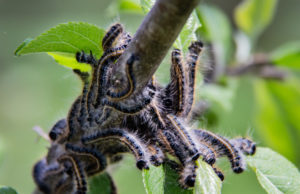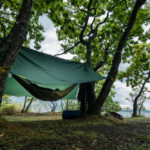Tent worms are also known as Eastern tent caterpillars or Malacosoma americanum. They do not pose much of a threat to us but they can be a real pain.
They are most commonly seen at the beginning of spring and make nests resembling tents in the branches of trees.
They are medium caterpillars that can eventually become moths.

Table of Contents
Where do they live?
There are 26 known species of tent caterpillars, of which 6 can be found in North America. The rest of them are commonly found in Eurasia.
Once they hatch, the tent worms will make their small silken tents where the early morning sun hits the tree. This allows them to warm up sufficiently to start their digestive process.
Tent worms are most often seen in ornamental fruit trees such as wild cherry trees but have been known to nest in maple trees, ash, and willow too.
Their nests, unlike the fall webworms, do not contain leaves and foliage.
What do they eat?
Tent worms feed on the leaves of the trees and if they are in a large group this can lead to defoliation.
Trees rarely die due to leaf loss, but it makes them a lot more susceptible to developing diseases. Tent worms may also feed on other nearby plants and vegetation.
As they travel to their food source, the tent worms release a stream of pheromones to make the path that they took.
This means that they can easily make it back to their home and ensures other tent worms can find the food source too.
Tent worms are not very efficient at taking energy from their food, and nearly half of all they ingest is released as feces.
This means that large colonies of tent worms will produce a huge quantity of droppings which can be a pain.
As these pellets drop from the branches of the tree and land on your tent, it will sound a lot like rain falling.
How to remove tent worms
Generally speaking, you can pick out the egg sacs and nests using your hands. Sometimes the tent worms can be located as high as 30 feet in the air, right at the top of the tree.
There are many different methods to remove tent worms that are all highly effective.
Birds
Birds are a natural predator to the tent worm, so all this method involves is promoting the natural order of the world. We suggest hanging a birdhouse in your tree to draw in the birds, to begin with.
If your infestation is located higher in the tree, you can install a birdhouse or feeder higher in the branches.
This is likely to draw the attention of the birds to the tent worms, and hopefully, they will eat them. If you have a cat, hanging your birdhouse higher will likely help to protect the birds too.
Knocking
It is very easy to simply dislodge the tent worms’ nest from the branches. This can be done using a brush or pole lying around your home. If they are up high, we suggest climbing up a ladder to reach easily.
You could also use a spray of pressurized water to force the tent worms and their homes out of the tree.
Other species
You can also use natural predators of the tent worm to control their population. Parasitic Cotesia, Bracon, and Hyposter wasps are all predators of the tent worm, particularly in their larval stages.
The Trichogramma wasp attacks the eggs of tent worms. Assassin bugs and paper wasps will also eat live tent worms.
Pesticide
There is a natural pesticide found in soil known as BT (Bacillus thuringiensis or Bt-kurstaki) which is highly effective.
It is a caterpillar, worm, and moth larvae killing microbe spray. It is a selective insecticide, meaning that it will directly target certain species while leaving others completely untouched.
All you need to do is apply the spray to the affected area and allow it to sit.
After a while, you will see the tent worms beginning to drop off the branches of the tree onto the ground where they no longer pose an issue. These are safe to use around children and pets.
You can also apply insecticides as a spot treatment for tents created by the worms. The most effective time to do this is in the evening or at dawn, as this is when the tent worms are most lively.
During the winter period, you can cover the eggs with dormant oil which will coat them evenly.
You can also purchase insecticidal soaps which are effective but must be applied directly onto the tent worms to work correctly.
Spinosad is a fermented biological agent that is created organically. It is very useful for use on insects and is the main ingredient in Monterey Garden Insect Spray.
Another good insecticide is azadirachtin, found in AzaMax and neem oil. It hinders the growth of insects, acts as a repellent, and prevents feeding on the tree.
It is also a selective product and leaves honey bees and other useful insects unharmed.
Pruning
In the winter, you should be pruning your trees and plants. During this time, you can check the branches of your trees for clumps of eggs.
These will look like small swellings and can be removed and disposed of. This will mean that the eggs are gone from the tree before they even hatch.
Any webs that you notice on the branches of the tree during the spring should be removed too.
Traps
There are many commercially available tent worm traps. These tend to be sticky and similar in appearance to tape.
You can install these near the base of the tree, as well as multiple locations in the branches. This will ensure the most tent worms are caught.
Live tent worms
You should kill any tent worms that you see running about your home and trees. This can be done by crushing them or submerging them in a bucket of warm soapy water.
- Are Merrell Shoes Good? – An Unbiased Review of Merrell Footwear - December 9, 2023
- Where Are Merrell Shoes Made? - December 9, 2023
- Camping in 40-degree Weather: Tips and Tricks - September 25, 2023


![How to Get Rid of Flies When Camping? [Easiest Ways] How to Get Rid of Flies When Camping? [Easiest Ways]](https://grandcircletrails.com/wp-content/uploads/2022/07/How-to-Get-Rid-of-Flies-When-Camping-150x150.jpg)

![How to Get Campfire Smell Out of Clothes? [Proven Ways] How to Get Campfire Smell Out of Clothes? [Proven Ways]](https://grandcircletrails.com/wp-content/uploads/2021/11/How-to-Get-Campfire-Smell-Out-of-Clothes-1-150x150.jpg)
![How to Get Smell Out Of Yeti Cooler? [Ways To Remove Odors] How to Get Smell Out Of Yeti Cooler? [Ways To Remove Odors]](https://grandcircletrails.com/wp-content/uploads/2022/02/How-to-Get-Smell-Out-Of-Yeti-Cooler-1-150x150.jpg)
![How to Get Burrs Out of Clothes? [Most Effective Ways] How to Get Burrs Out of Clothes? [Most Effective Ways]](https://grandcircletrails.com/wp-content/uploads/2022/06/How-to-Get-Burrs-Out-of-Clothes-150x150.jpg)